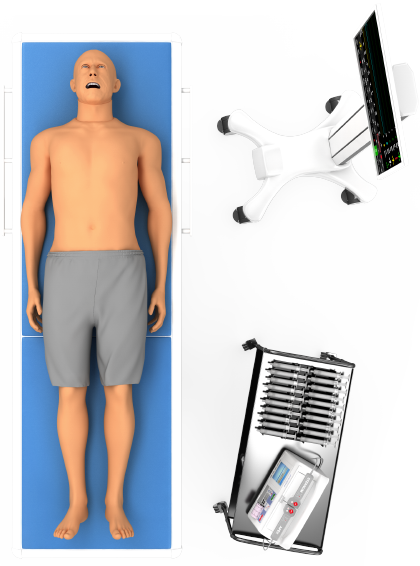 |
ENSIM RAN
High fidelity patient simulator designed for training in performance of cardiopulmonary resuscitation, intensive care, and life-support procedures
Part number:
Supplier:
K.K. MedVisionDescription
Improving Emergency Preparedness Of Medical Professionals Through Simulation Training And Interprofessional Education
Automatic blinking, depending on the physiological state of the patient; pupils’ reaction to the light or touching of the eyeball
Physiological model, correlated with the patient age
Simulation of patient speech, coughing, moaning, screaming; possibility of voice communication with the trainee (imitation of active speech) via microphone
Pulse: 12 points
Imitation of various types of secretion (bleeding, sweating, urination, tears, secretion from ears, nose, mouth)
Creation and editing of ECG graphs (additional software)
Lips and fingers cyanosis
Real-time tracking and analysis of the CPR procedure performance
Possibility of inputting individual breathing settings for the lungs (right / left)
Life-like mobility and flexion of major joints - neck, shoulders, knee, hip, elbow etc; flexion of the hands and fingers
Imitation of different types of seizures
Additional elements with imitations of injuries (arms and legs)
Virtual imitations of mechanical ventilation machine and anesthetic machine
Detailed automatic registration of all actions performed during exercise performance
ADAM.HF is a high-fidelity patient simulator: the highest standard of realism in form and function. It is designed for training in performance of cardiopulmonary resuscitation, intensive care, and life-support procedures using a wide variety of possible medical situations. Robot patient height – 183 cm, weight – 70 kg, age – 40-50 years.
Studying of Major Medical Skills such as
Performance of cardiopulmonary resuscitation procedure (CPR) in accordance with 2010-2015 AHA/ERC Guidelines for CPR and defibrillation with or without use of acute care medications and real defibrillator machine
Performance of intubation procedures, normal and with complications (which includes but not limited to tongue edema, laryngeal edema, laryngospasm (requires a coniotomy), left/right bronchus obstruction, trismus), using a variety of medical instruments such as endotracheal tubes, laryngeal mask airway (LMA), combitube and others
Decompression of tension pneumothorax
Performance of intramuscular, intraosseous and intravenous injections (with type and amount of the administered medicine being automatically recognized) by software
Performance of cricoid pressure technique (Sellick’s maneuver)
Performance of pleural cavity drainage
Auscultation and interpretation of heart, lungs and intestines sounds, and Korotkoff tones which requires a correct positioning of instrument
Performance of urethral catheterization
Automatic blinking, depending on the physiological state of the patient; pupils’ reaction to the light or touching of the eyeball
Physiological model, correlated with the patient age
Simulation of patient speech, coughing, moaning, screaming; possibility of voice communication with the trainee (imitation of active speech) via microphone
Pulse: 12 points
Imitation of various types of secretion (bleeding, sweating, urination, tears, secretion from ears, nose, mouth)
Creation and editing of ECG graphs (additional software)
Lips and fingers cyanosis
Real-time tracking and analysis of the CPR procedure performance
Possibility of inputting individual breathing settings for the lungs (right / left)
Life-like mobility and flexion of major joints - neck, shoulders, knee, hip, elbow etc; flexion of the hands and fingers
Imitation of different types of seizures
Additional elements with imitations of injuries (arms and legs)
Virtual imitations of mechanical ventilation machine and anesthetic machine
Detailed automatic registration of all actions performed during exercise performance
ADAM.HF is a high-fidelity patient simulator: the highest standard of realism in form and function. It is designed for training in performance of cardiopulmonary resuscitation, intensive care, and life-support procedures using a wide variety of possible medical situations. Robot patient height – 183 cm, weight – 70 kg, age – 40-50 years.
Studying of Major Medical Skills such as
Performance of cardiopulmonary resuscitation procedure (CPR) in accordance with 2010-2015 AHA/ERC Guidelines for CPR and defibrillation with or without use of acute care medications and real defibrillator machine
Performance of intubation procedures, normal and with complications (which includes but not limited to tongue edema, laryngeal edema, laryngospasm (requires a coniotomy), left/right bronchus obstruction, trismus), using a variety of medical instruments such as endotracheal tubes, laryngeal mask airway (LMA), combitube and others
Decompression of tension pneumothorax
Performance of intramuscular, intraosseous and intravenous injections (with type and amount of the administered medicine being automatically recognized) by software
Performance of cricoid pressure technique (Sellick’s maneuver)
Performance of pleural cavity drainage
Auscultation and interpretation of heart, lungs and intestines sounds, and Korotkoff tones which requires a correct positioning of instrument
Performance of urethral catheterization